…where east meets west
- Home
- Brief History
- The Greenwich Meridian
- Greenwich
(1675–1958) - Herstmonceux
(1948–1990) - Cambridge
(1990–1998) - Outstations (1822–1971)…
- – Chingford (1822–1924)
- – Deal
(1864–1927) - – Abinger
(1923–1957) - – Bristol & Bradford on Avon
(1939–1948) - – Bath
(1939–1949) - – Hartland
(1955–1967) - – Cape of Good Hope
(1959–1971)
- Administration…
- – Funding
- – Governance
- – Inventories
- – Pay
- – Regulations
- – Royal Warrants
- Contemporary Accounts
- People
- Publications
- Science
- Technology
- Telescopes
- Chronometers
- Clocks & Time
- Board of Longitude
- Libraries & Archives
- Visit
- Search
The Quartz Clocks installed at Abinger and Greenwich from mid-1944 onwards
Page under construction
The acquisition of quartz clocks by the Observatory can be broken down into seven distinct parts of phases. This page deals with phases 3, 4 and 5. A brief overview of each of these phases is given below. For links and information on the other phases, see An introduction to the quartz clocks of the Greenwich Time Service.
Phase 3 (commenced 1944)
Installation of eighteen oscillators with GT-cut Crystals designed and built by GPO to their Group IV design specification. Twelve oscillators were installed in four groups of three at Abinger (Groups B, C, D & E) and six in two groups of three (A & F) at Greenwich. The oscillators were rack mounted, with all three from a group mounted one above the other on the same rack. Two of the oscillators from Phase 2 were incorporated into Group B. The installation of the Abinger clocks was completed in October 1946 and the Greenwich clocks in November 1947.
Phase 4 (commenced 1950)
Upgrading of Phase 3 installation at Abinger by separating oscillators onto separate brick piers, modifying electrical circuity and replacing GT-cut crystals with Essen Ring Crystals. Group A at Greenwich was also rebuilt using the original GT-cut crystals retained and renamed as H1 & H3. Although the general practice was to rename the clocks when new crystals were substituted for existing ones, this was does not seem to have been the case with the later alterations in the B and D groups.
Phase 5 (commenced 1951)
Construction of experimental Clocks at Abinger. These allowed new clocks and circuits to be designed and tested against the existing. They were named G1, G2, G3 and G4. Also includes test on clock PTR VIII which was removed from Germany after the Second World War as part of the German reparations.
By monitoring the comparative rates of the different quartz oscillators at the observatory (which was easy to do), the best performing ones at any particular time could be connected to a set of dividers and phonic motors that could be switched from one oscillator to another as circumstances dictated. As a result, most ot the Observatory clocks did not have divider-circuits and phonic motors of their own. In the literature both the Astronomer Royal, Harold Spencer Jones, and the Head of the Time Department, Humphry Smith, referred to the individual oscillators as clocks for the sake of simplicity. This practice is continued here.
A brief history of Quartz clocks at the Observatory up to and including phase 3 which was completed in 1947
The following introductory text is taken from Humphry Smith's paper Quartz Clocks of the Greenwich Time Service
‘The first quartz clock of the Observatory was installed at Greenwich in 1939, and was of the pattern developed at the National Physical Laboratory. This employed a ring crystal supported on phosphor-bronze pins and mounted in an evacuated glass vessel held at a constant temperature by means of a mercury thermometer. The crystal was incorporated in a simple Pierce oscillator circuit, and was designed to oscillate at 99*3 kc/s. The divider chain performed successive division by 3, 6 and 11, giving an output of 500 cycles per sidereal second to drive a phonic motor. This clock, Q3, took its place among the standard pendulum clocks of the Time Service, which were also supplemented by data received daily from the National Physical Laboratory regarding two similar quartz clocks Q2 and Q6.
Clocks employing GT-cut plate crystals in a drive circuit based upon the Meacham bridge were developed independently at the Post Office Radio Branch Laboratories. The oven and temperature-control arrangements were essentially a simplified version of the thermostat designed by Turner. The fundamental crystal frequency was 100 kc/s, which was converted by means of regenerative dividers into a 1 kc/s output used to drive a phonic motor. A group of three such oscillators, known as “Group 4” attained a high standard of performance, and in 1942 arrangements were made for information relating to these clocks to be communicated daily to the Royal Observatory where it proved of the greatest value. Within a year it became clear that the long-term performance of these clocks was so markedly superior to even the best of the pendulum clocks available to the Time Service that the pendulum clock was rendered virtually obsolete as a long-term standard.
It was clearly desirable that similar quartz clocks should be installed at the Observatory, so that the Service would not be entirely dependent upon primary standards at an external establishment. There was also an urgent need for secondary standards having good day-to-day stability for the control of the signals, and in this respect also the superiority of the quartz clock had been established. The first three clocks supplied by. the Post Office were of the Group 4 pattern, and were brought into use early in 1944 for the control of the GBR radio time signals, thus bringing about a considerable improvement in the day-to-day uniformity of these time signals. Unfortunately, the value of these clocks as long-term standards was seriously impaired by the fact that they were mains operated and that, under war-time conditions, interruptions of the mains electricity supply were of frequent occurrence. It was thus still necessary to base the service on the Post Office Group 4 standards.
During 1945 [and early 1946] four groups of three oscillators, similar in general arrangements to the Post Office Group 4, were installed in new clock cellars at the Observatory station at Abinger. These oscillators, together with their ancillary equipment, were designed for battery operation, and an extensive installation of batteries and control equipment, together with a stand-by diesel generator, was provided. This overcame the main cause of disturbance to the oscillators, and longer uninterrupted clock runs were made possible. The temperature-control circuits, however, were still dependent on a 50 c/s a.c. supply, and in the event of mains failures this was provided automatically by a battery-driven motor alternator. Two similar groups of three oscillators each were subsequently installed at Greenwich, and incorporated some minor improvements. Special types of phonic motors were developed in order that all requirements of the service could be provided directly from the quartz clocks. Motors incorporating sidereal gearing were used to provide sidereal seconds for the astronomical time observations; and more elaborate timing devices, capable of producing the various forms of time signal distributed by the Department, made the full accuracy of the quartz clocks available for direct practical use. It had thus become possible for the quartz clocks to perform, with greater accuracy, all the functions hitherto carried out by the pendulum clocks: in fact, the manifest inferiority of the pendulum clocks led to their complete elimination.
One result of the widespread employment of quartz clocks was that the clock comparison equipment which had been adequate for use with pendulum clocks was found to be incapable of meeting the new demands for accuracy. In particular, it became necessary to replace the electro-mechanical chronographs by fully electronic decimal counter chronometers. Moreover, quartz clocks may be conveniently intercompared with great accuracy by methods which are inapplicable to pendulum clocks. Relative rates may be readily obtained by means of a precision beat comparator and integrated time differences between standards by means of rotary beat counters. It thus becomes possible to maintain a constant check on the performance of all oscillators and to connect the dividers and phonic motors to those oscillators giving the best
performance at the time.
As initially installed, the three oscillators of each group were mounted on
one rack, in accordance with standard Post Office practice.’
Full details including drawings, circuit diagrams, but no photographs of the 18 clocks installed at Abinger and Greenwich between 1945 and 1947 can be found in the following report,
The quartz crystals in the 18 clocks
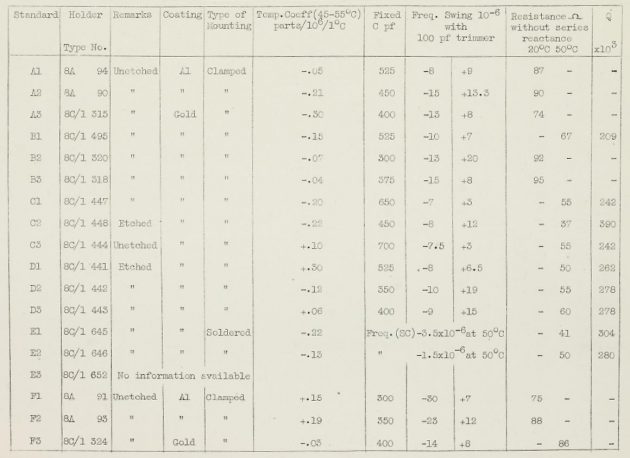
Table showing the serial numbers and other details of the quartz crystals supplied by the Post Office (1944-1948). © BT Heritage. From Post Office Radio Report No, 1752 . Reproduced under the terms of a Creative Commons Attribution-Non-Commercial-ShareAlike (CC BY-NC-SA) licence (see below)
The set up at Abinger
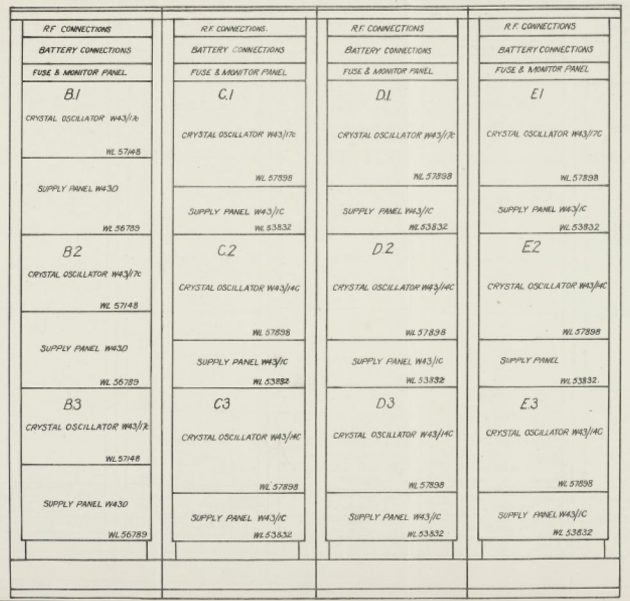
The rack layout for each of the four groups of three oscillators at Abinger. Each rack was installed in a different cellar. © BT Heritage. Drawing WL 58756 from Post Office Radio Report No, 1752 . Reproduced under the terms of a Creative Commons Attribution-Non-Commercial-ShareAlike (CC BY-NC-SA) licence (see below)
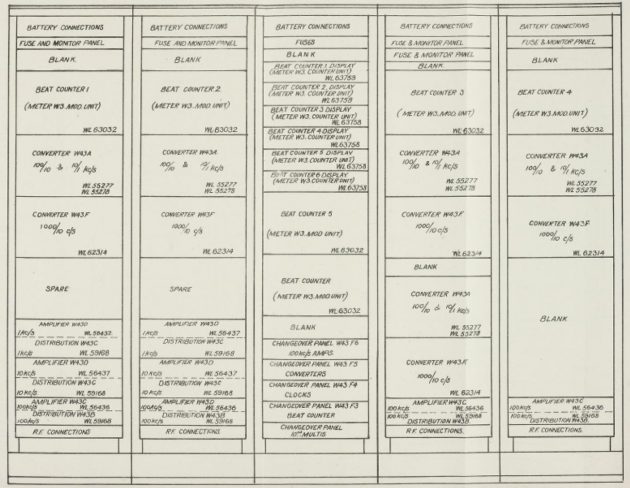
The rack layout for the beat counters at Abinger. They were installed side by side in the same order as above in the Control Room. © BT Heritage. Drawing WL 58756 from Post Office Radio Report No, 1752 . Reproduced under the terms of a Creative Commons Attribution-Non-Commercial-ShareAlike (CC BY-NC-SA) licence (see below)
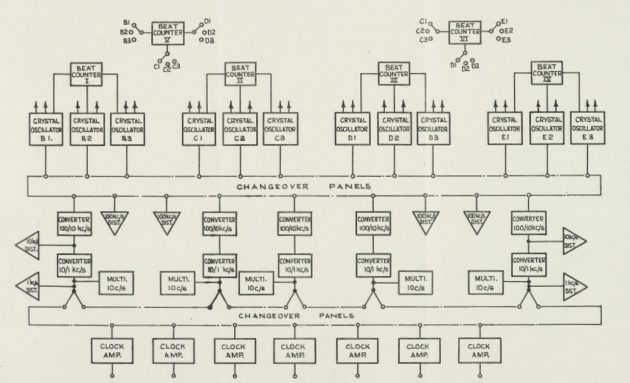
Schematic diagram of the general arrangement at Abinger. © BT Heritage. Drawing WL 60567 from Post Office Radio Report No, 1752 . Reproduced under the terms of a Creative Commons Attribution-Non-Commercial-ShareAlike (CC BY-NC-SA) licence (see below)
The set up at Greenwich
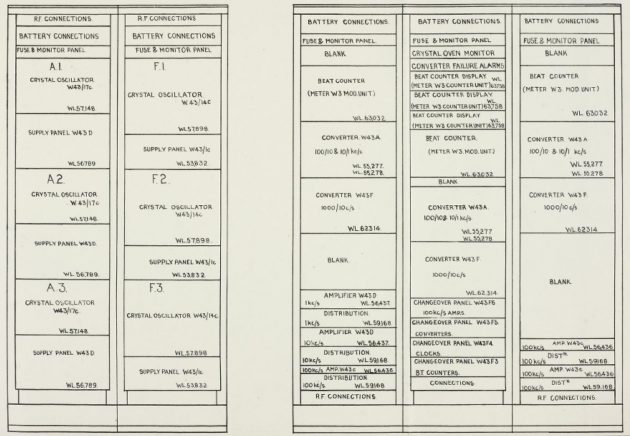
The rack layout for the oscillators (left) and beat counters (right) at Greenwich. © BT Heritage. Drawing WL 58758 from Post Office Radio Report No, 1752 . Reproduced under the terms of a Creative Commons Attribution-Non-Commercial-ShareAlike (CC BY-NC-SA) licence (see below)
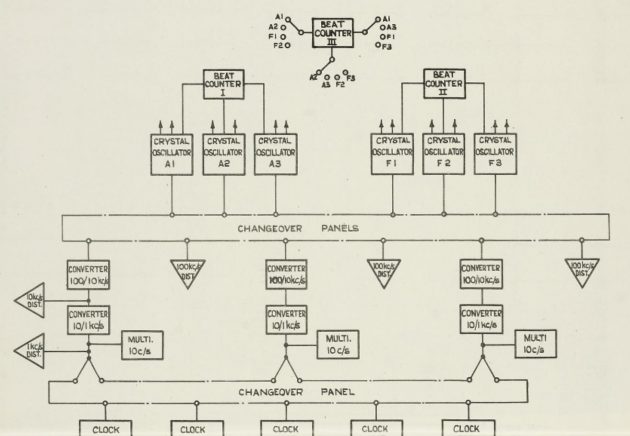
Schematic diagram of the general arrangement at Greenwich. © BT Heritage. Drawing WL 60566 from Post Office Radio Report No, 1752. Reproduced under the terms of a Creative Commons Attribution-Non-Commercial-ShareAlike (CC BY-NC-SA) licence (see below)
The German Clock
Post Office Engineering Department, Radio Report No.1610 (1947)
Acknowledgements
The drawings marked © BT Heritage are from The BT Digital Archives and are reproduced under the terms of a Creative Commons Attribution-Non-Commercial-ShareAlike (CC BY-NC-SA) licence issued on 23 July 2013 and come from the following Report: Quartz Clocks for the Royal Observatory. Post Office Engineering Department, Radio Report No.1752 (1948)
© 2014 – 2026 Graham Dolan
Except where indicated, all text and images are the copyright of Graham Dolan